2 中国科学院大学, 北京 100049
2 University of Chinese Academy of Sciences, Beijing 100049
中国南海(the South China Sea,SCS)位于亚澳季风区的中心,是连接南亚季风、东亚季风、西北太平洋季风和澳洲季风等季风子系统的纽带(何金海等,2001;Wang et al., 2009)。南海夏季风爆发(South China Sea Summer Monsoon Onset,SCSSMO)被认为是东亚夏季风建立的开始和中国东部雨季的前兆(Tao and Chen, 1987;Lau and Yang, 1997;Wang and LinHo, 2002)。季风爆发受到大气外强迫因子和大气内部动力过程的共同影响,已有大量研究致力于理解与其有关的物理机制(如:邵勰等,2014;刘伯奇和何金海,2015;Xue et al., 2015)。研究表明,季风爆发的年际和年代际变化受到季节内振荡(Zhou and Chan, 2005;Tong et al., 2009;Lee et al., 2013;林爱兰等,2016)、热带气旋(Mao and Wu, 2008;黄菲和李元妮,2010;Kajikawa and Wang, 2012)、中纬度锋面(Tong et al., 2009)等许多因子的影响,其中海温(Sea Surface Temperature,SST)是非常重要的外强迫。赤道中东太平洋冷舌、热带西太平洋暖池、南海、热带印度洋等海域的海温强迫都会影响到南海夏季风爆发;并且,上述海域海温的年际变化并非独立,而是与ENSO有密切关系(邵勰等,2014)。ENSO不论是在年际还是在年代际尺度上都对南海夏季风的爆发有重要影响。Zhou and Chan(2007)指出在ENSO暖位相的当年和次年,南海夏季风爆发偏晚。丁硕毅等(2016)指出在季风爆发的1993/1994年年代际突变之前(Kajikawa and Wang, 2012;Kajikawa et al., 2012;Xiang and Wang, 2013),南海夏季风爆发主要受东太平洋型海温异常的影响,之后则主要受中太平洋型海温异常影响。前期海温分布如果为赤道中东太平洋偏暖(Zhou and Chan, 2007)、热带西太平洋偏冷(黄荣辉等,2003)、南海暖池偏暖(赵永平和陈永利,2000)、印度洋全区一致增暖型(IOBW)(袁媛和李崇银,2009),则有利于南海夏季风爆发的推迟,反之南海夏季风爆发则偏早。此外,也有研究指出冬季大气环流异常与后期南海夏季风爆发存在联系,当冬季风偏强时夏季风爆发偏早,反之则偏晚(孙淑清和陈隽,2000;陈隽和金祖辉,2001)。
相比于南海热带夏季风和东亚副热带夏季风,东亚冬季风所受到的关注则少得多,这可能是因为它的社会经济影响不如夏季风那么巨大(Chan and Li, 2004)。作为全球最强大的冬季风和北半球冬季最活跃的环流系统,东亚冬季风的主要天气现象包括冷涌和温带气旋爆发性发展(Chan and Li, 2004;丁一汇,2005),前者甚至可以影响到海洋性大陆的对流活动和南半球的热带气旋生成(陈隆勋等,1991;Chan and Li, 2004;丁一汇,2005;Chang et al., 2006)。除了上述天气尺度的过程外,东亚冬季风与其他行星尺度系统或外强迫因子在不同时间尺度上都存在着关联,例如阻塞高压、北极涛动(AO)、北大西洋涛动(NAO)、北太平洋涛动(NPO)、极涡及平流层环流、青藏高原热力状况、欧亚大陆积雪、太平洋年代际振荡(PDO)、大西洋多年代际振荡(AMO)等(Chan and Li, 2004;陈文等, 2008, 2013;Chen et al., 2014;Ding et al., 2014;黄荣辉等,2014;Wang and Chen, 2014;肖晓等,2016);并且,东亚冬季风可以对北美等地的气候产生影响(Yang et al., 2002)。年际尺度上,ENSO通常被认为是影响东亚冬季风最重要的因子(陈文等,2013)。ENSO还可以显著地影响东亚冬、夏季风循环(陈文,2002);反之,季风也可以影响ENSO循环(Wang and Li, 2004)。本文拟研究的正是ENSO、东亚冬季风和夏季风(爆发)三者的关系。东亚冬季风与ENSO的相互作用已有相当多的研究(李崇银,2000;黄荣辉和陈文,2002;黄荣辉等,2003;Wang and Li, 2004;Chang et al., 2006)。一方面,持续而强盛的冬季风对El Niño事件有激发作用(李崇银和胡季,1987;Li,1990);但这只是一个必要条件(Chan and Li, 2004),只有在后期伴随有强的澳洲冬季风时往往才有El Niño发生(Chen and Wu, 2000)。另一方面,El Niño会导致东亚冬季风偏弱、气温偏高(Li,1990;Chen et al., 2000;李崇银,2000),研究并认为这是通过菲律宾海异常反气旋(Anomalous Anticyclone over the Philippine Sea,AACPS)(Zhang et al., 1996)和“太平洋—东亚”型遥相关(Wang et al., 2000;Wang and Li, 2004)等机制来实现的。菲律宾海异常反气旋可以从冬季一直持续到春季甚至夏季(Wang et al., 2000;Wang and Li, 2004;Xie et al., 2009, 2016)。需要注意的是,ENSO和东亚冬季风的关系并不稳定(Wang et al., 2008;Wang and He, 2012;Yun et al., 2014),它会受到PDO、AMO等的调制(Chen et al., 2013;He and Wang, 2013;Ding et al., 2014)。虽然很早就有证据暗示东亚冬季风与夏季风之间存在联系(Chen et al., 1992;陈乾金等,2000;Wu and Chan, 2005a,2005b),但这一问题仍值得深入研究。一方面,夏季风降水会改变秋季和早冬的土壤湿度,进而通过影响辐射冷却来调节南北温度梯度和大气斜压性,由此对冬季风产生影响(Chan and Li, 2004);以及华南冬季偏冷、强冬季风的前期一般对应着弱的东亚夏季风(吴尚森和梁建茵,2000)。另一方面,冬季风异常所表现出来的环流异常可以一直持续到次年春季甚至夏季(陈隽和孙淑清,1999;Chen et al., 2000, 2013),从而对夏季风时期的环流和降水产生影响(Sun and Sun, 1994;孙淑清和孙柏民,1995)。
最近,Chen et al.(2013)研究了ENSO和PDO在东亚冬季风与后期夏季风关系中的作用。Feng and Chen(2014)、周群和陈文(2014)、徐霈强等(2016)在此工作的基础上,进一步研究了太阳活动11年周期的调制作用、与ENSO无关的东亚冬季风的干扰作用以及ENSO的不对称影响等。但上述研究关注的是整个夏季,并没有考虑自冬季向夏季的转换季节,而过渡季节同样十分重要(Kajikawa et al., 2012);此外,以往研究的重点主要是东亚副热带季风而不是南海热带季风,而二者包括爆发在内的许多特征存在明显差异(Wang and Lin, 2002)。至于东亚冬季风—南海夏季风爆发的关系,前人研究(孙淑清和陈隽,2000;陈隽和金祖辉,2001)由于资料长度问题,存在一定的局限性。因此有必要利用更长期、尤其是有卫星观测之后更准确的资料来进一步研究该问题,确认二者是否真的存在联系、有什么样的联系,以及如何解释这些联系。南海夏季风爆发的特征之一就是纬向风由东风向西风的突变(何金海等,2001;Wang et al., 2004;Ding et al., 2015),从Chen et al.(2013)中的图 5可以看出与ENSO有关的弱东亚冬季风后期的春季和夏季,南海位于菲律宾异常反气旋南侧,盛行偏东气流;而在与ENSO无关的弱东亚冬季风后期的春夏则无明显信号。此外,前期海温异常对季风爆发早晚有指示意义(赵永平和陈永利,2000;黄荣辉等,2003;Zhou and Chan, 2007;袁媛和李崇银,2009;邵勰等,2014),从Chen et al.(2013)中的图 6还可以发现与冬季风异常有关的印度洋和太平洋的海温信号在有、无ENSO信号时也有显著不同。菲律宾海反气旋异常、南海东风异常、前期海温异常必然会影响到夏季风爆发的早晚,那么ENSO在“东亚冬季风—南海夏季风爆发关系”中又扮演着什么样的角色呢?这些将是本文试图探讨的科学问题,回答它们无疑将增进我们对ENSO—季风关系的认识和了解。
本文后续结构安排如下:第二部分介绍了资料和方法;第三部分介绍了东亚冬季风强度、南海夏季风爆发的刻画方式;第四部分利用相关分析研究了东亚冬季风与南海夏季风爆发的关系,并分析了ENSO在其中的作用;最后在第五部分对全文进行了总结与讨论。
2 资料和方法本文采用的资料有ERA-interim再分析资料(Dee et al., 2011),其水平分辨率为1°(纬度)×1°(经度),时间范围为1979~2016年。为简洁起见,将冬季风时间记为夏季风爆发所在年份,即1980年冬季是指1979年12月、1980年1月和2月,以此类推。此外,在确定南海夏季风爆发日期时还综合考虑了NCEP/NCAR(Kalnay et al., 1996)和NCEP-DOE(Kanamitsu et al., 2002)两套再分析资料集,它们的水平分辨率均为2.5°(纬度)×2.5°(经度)。降水资料采用了CMAP(Xie and Arkin, 1997),海温资料采用的是美国国家海洋和大气管理局(NOAA)的ERSST.v4(Huang et al., 2015)。Niño3指数取自美国国家环境预报中心(NCEP)气候预报中心(CPC)的网站(http://www.cpc.ncep.noaa.gov/data/indices/ersst4.nino.mth.81-10.ascii [2017-02-01])。本文的研究方法主要有回归分析和相关分析。
3 东亚冬季风强度、南海夏季风爆发的刻画方式 3.1 东亚冬季风强度对东亚冬季风而言,目前至少有二十余个指数来描述其强度特征(Li and Yang, 2010,Wang and Chen, 2010;邵鹏程和李栋梁,2012;Wang and Chen, 2014;Hu et al., 2015)。本文选择用Chen et al.(2000)这一侧重于低层风场的指数来刻画冬季风强度,文中基于此指数的所有分析结果同时经由Yang et al.(2002)的冬季风指数的交叉验证,利用两个指数的结果基本一致。Chen et al.(2000)定义的东亚冬季风指数(EAWMI)为南海(10°N~25°N, 110°E~130°E)和东海(25°N~40°N,120°E~140°E)平均的10 m经向风。当EAWMI偏高时,表明上述地区有异常南风,东亚冬季风偏弱;反之,东亚冬季风偏强。该指数在热带太平洋地区也有很强的信号,可以很好地刻画ENSO—冬季风关系(Wang and Chen, 2010;Hu et al., 2015)。
仿照Chen et al.(2013)的做法,采用Niño3指数对EAWMI进行线性回归,将其拆分成与ENSO有关的部分(EAWMIEN)和与ENSO无关的部分(EAWMIres),结果如图 1。这种通过回归分析进行拆分是一种较常见的做法(例如,Zhang et al., 1997;Wu and Wang, 2002)。Niño3指数与EAWMI的线性关系较好,相关系数达0.69,远超99.9%的置信度检验。从图 1可以看出,对于Niño3指数较高的冬季(El Niño年),EAWMI也较高,即东亚冬季风偏弱;反之则偏强。这与前人结论吻合(Li,1990;李崇银,2000;Wang et al., 2000)。进一步还可以看出ENSO对东亚冬季风的影响表现出非对称性,最强的几次El Niño事件基本对应着偏弱的冬季风,但最强的几次La Niña事件,对应的冬季风有的偏强、有的接近正常;此外,弱东亚冬季风基本都对应着El Niño事件,而强东亚冬季风对应的Niño3指数并不总是异常偏低。
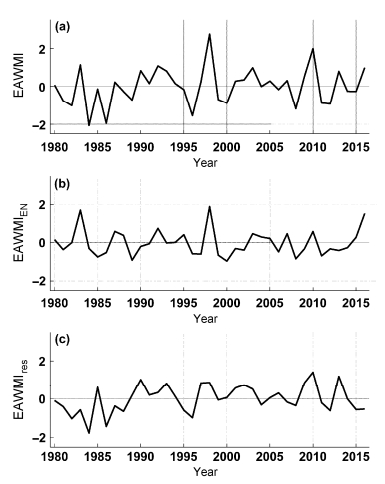
|
图 1 1979~2016年(a)东亚冬季风指数(EAWMI)、(b)与ENSO有关的东亚冬季风指数(EAWMIEN)、(c)与ENSO无关的东亚冬季风指数(EAWMIres)随时间变化。EAWMIEN和EAWMIres分别解释了EAWMI总方差的47.4%和52.6% Fig. 1 Time series of (a) EAWMI (East Asian Winter Monsoon Index), (b) ENSO-related part of the EAWMI (EAWMIEN), (c) ENSO-unrelated part of the EAWMI (EAWMIres) during 1979−2016. The EAWMIEN and EAWMIres contribute 47.4% and 52.6% of the total EAWMI variance, respectively |
以0.7倍标准差作为强、弱冬季风事件和ENSO事件的挑选标准,挑选出的强、弱冬季风个例和对应的ENSO事件见表 1。可以看到,9个最弱的冬季风个例中,有6年对应于El Niño;10个最强的冬季风个例中,也有6年对应于La Niña。这说明东亚冬季风会受到ENSO的强烈影响。但研究也表明,ENSO只是影响因子之一,除此以外仍有许多其他的因子可以影响冬季风异常(Chan and Li, 2004;陈文等, 2008, 2013;Chen et al., 2014),例如AO(Gong et al., 2001;Wu and Wang, 2002)。
|
|
表 1 强、弱东亚冬季风与ENSO事件的对应关系 Table 1 Strong and weak EAWM (East Asian Winter Monsoon) classified by ENSO events |
关于南海夏季风爆发日期的确立,前人已有过诸多研究(Ding et al., 2015)。Wang et al.(2004)基于南海中部—南部海域(5°N~15°N,110°E~120°E)平均的850 hPa纬向风,结合客观判据得到爆发日期,效果较好。Kajikawa and Wang(2012)和丁硕毅等(2016)在分析季风爆发的年代际变化时沿用此方法,但将时间分辨率由候改为日。由于参数的选择具有一定的经验性(Wang et al., 2004),且可能对资料集敏感,本文基于这两种判断方法对ERA-interim、NCEP/NCAR、NCEP-DOE 3套再分析资料集分别确立爆发日期;对存在分歧的年份,结合环流场分析和前人研究进行人工校准,得到图 2所示的南海夏季风爆发时间序列。1980~2016年平均的爆发日期为5月21日,非常接近于前人确定的5月第4候(何金海等,2001)。此外,南海夏季风爆发日期存在较大的年际和年代际变率,其标准差约为2周。

|
图 2 南海中部—南部海域平均的850 hPa纬向西风(填色)和最终确定的南海夏季风爆发(SCSSMO)日期,红、蓝色散点是Kajikawa and Wang(2012)和丁硕毅等(2016)的判断方法对3套再分析资料集EAR-interim、ECEP/NCAR和NCEP-DOE分别得到的爆发日期 Fig. 2 850-hPa westerly winds (colored) over the central and southern parts of the South China Sea and the SCSSMO (South China Sea Summer Monsoon Onset) date. The blue and red scatters are the SCSSMO dates based on ERA-interim, NCEP/NCAR, NCEP-DOE reanalysis datasets according to Kajikawa and Wang (2012) and Ding et al. (2016), respectively |
为了研究东亚冬季风与后期南海夏季风爆发的关系,计算EAWMI与同期冬季和后期5月低层风场的相关。由图 3a可见,对应于偏高的EAWMI,同期冬季在西北太平洋有一个巨大的异常反气旋。它包含两个相对独立的中心,一个位于菲律宾以东(约10°N,130°E),另一个位于日本以东约(40°N,160°E)。在西北太平洋的反气旋西侧、东亚沿岸地区有异常偏南风,与该地区气候平均态的偏北风[见Chen et al.(2000)中的图 1]方向相反,说明东亚冬季风偏弱。图 3b显示随后的5月在南海中部—南部海域出现显著的东风异常,南海—菲律宾海被一异常反气旋控制。纬向风自东风向西风的突变和副热带高压的东撤正是南海夏季风爆发的特征(何金海等,2001;Wang et al., 2004;Ding et al., 2015),此异常东风和异常反气旋显然不利于南海夏季风的爆发。
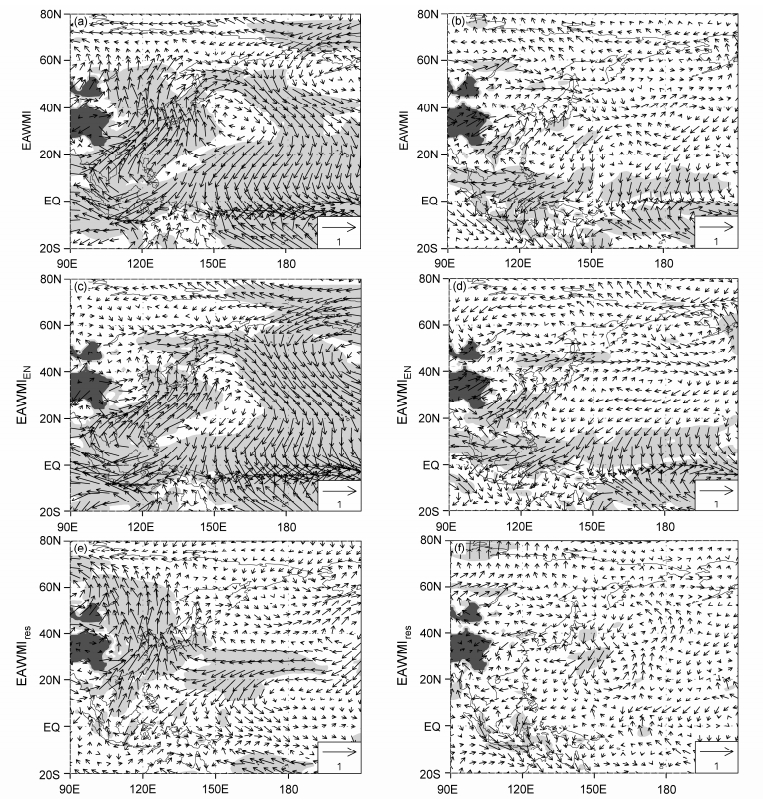
|
图 3 (a、b)EAWMI、(c、d)EAWMIEN和(e、f)EAWMIres与同期冬季(左列)、后期5月份(右列)850-hPa风场的相关。浅色阴影区通过了95%的置信度检验,深色阴影为海拔高于1500 m的高原地区 Fig. 3 Correlation coefficients between the (a, b) EAWMI, (c, d) EAWMIEN, (e, f) EAWMIres with 850-hPa wind in the winter (left column) and in the subsequent May (right column). The light shading indicates the 95% confidence level and the dark shading indicates the plateau higher than 1500 m |
图 3a中异常风场的分布型与El Niño年合成的地表风场较为类似[见Wang et al.(2000)中的图 4]。因而有理由认为ENSO在此过程中扮演着重要角色。为了更清楚地看到它们之间的关系,分别计算了EAWMI、EAWMIEN、EAWMIres与南海夏季风爆发日期的相关系数,结果为0.128、0.313和−0.121。EAWMI和爆发日期呈正相关,即前冬为弱冬季风(EAWMI偏高)时爆发偏晚(SCSSMO较晚),与前人结论一致(孙淑清和陈隽,2000;陈隽和金祖辉,2001),但是该相关系数未能通过显著性检验。然而,与ENSO有关的冬季风EAWMIEN与爆发日期的相关系数明显增大,且通过了95%的显著性检验;对于与ENSO无关的冬季风EAWMIres,相关关系就不能通过显著性检验。
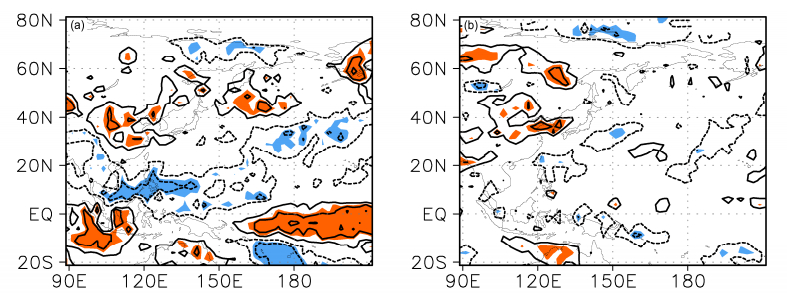
|
图 4 (a) EAWMIEN和(b)EAWMIres与后期5月份降水的相关系数分布。等值线间隔0.2,零线省略,实线表示正值,虚线表示负值;填色区表示通过了95%置信度检验 Fig. 4 Correlation coefficients of (a) EAWMIEN and (b) EAWMIres with precipitation in the subsequent May. The contour interval is 0.2 and the zero line is omitted, solid lines denote positive, dashed lines denote negative, shadings denote the 95% confidence level |
为了进一步揭示ENSO在东亚冬季风—南海夏季风爆发关系中的作用,计算了EAWMIEN和EAWMIres与同期冬季、后期5月低层风场的相关。对比图 3c和图 3a,EAWMIEN与同期冬季低层风场相关的信号在热带—副热带地区及西北太平洋与EAWMI基本相似,但在东亚沿岸的中纬度地区(40°N以北)的显著性有所下降。对比图 3e和图 3a,与EAWMIres相关联的同期冬季低层风场的异常在东亚沿岸、亚洲大陆中高纬等地表现出偏南气流和日本反气旋南侧偏东气流的信号。这可能是因为东亚冬季风包括低纬和高纬两个子系统,它们主要受不同的环流系统和外强迫因子影响(Chen et al., 2014),低纬地区冬季风系统与ENSO的联系更为紧密。图 3d与图 3b基本相似,最明显的特征就是在后期5月份南海周边地区出现了显著的异常东风和异常反气旋;此外,赤道中东太平洋有异常辐合和异常西风;图 3f则没有明显的异常信号。因此,对低层风场的相关分析确认了ENSO在东亚冬季风—南海夏季风爆发关系中的重要角色,ENSO主要影响低纬地区的东亚冬季风,且只有当东亚冬季风异常与ENSO有关时才会与后期的南海低层大气环流及夏季风爆发存在联系。
鉴于降水和对流活动也可以反映夏季风爆发特征(Wang and Lin, 2002;Wang et al., 2004),下面再从这个角度来确认相关结论。图 4是EAWMIEN和EAWMIres与后期5月降水的相关。可见若冬季风与ENSO有关,对应于菲律宾海异常反气旋、自孟加拉湾到西北太平洋的异常东风,南海—菲律宾海5月的降水显著偏少,正对应着南海夏季风爆发偏晚。此外,在长江以北地区、100°E附近的南半球热带地区和赤道中东太平洋的降水显著偏多,它们分别对应于长江以南的偏南风和长江流域附近的异常辐合、偏弱的南海低空越赤道气流和赤道中东太平洋的异常辐合及偏西风。而对于与ENSO无关的东亚冬季风,在低纬地区则无明显信号。这就从降水的角度验证了上述结论。对表 1中伴随ENSO事件的异常冬季风年的降水合成也显示出相似的信号(图略)。
图 3、图 4对环流和降水的相关分析都证实了ENSO在东亚冬季风—南海夏季风爆发关系中存在重要作用,那么该如何来理解这种作用呢?由于大气的混沌本性,其记忆力最长不超过两周,单凭冬季风本身不可能对数月之后的大气环流型、夏季风爆发产生影响。因而这种关联必然要通过海洋或陆地等记忆力较长的气候系统分量才能得以实现。图 5是EAWMIEN和EAWMIres与同期冬季、后期5月海温的相关。可以看到,对于与ENSO有关的冬季风(图 5a),同期冬季的太平洋海温分布呈典型的El Niño型分布,在赤道中东太平洋有正海温异常,从热带西太平洋到副热带太平洋有马蹄状的负海温异常;在南海及其他东亚边缘海也出现正海温异常,这可能是异常南风减弱了东亚冬季风,使得海洋损失热量减少、异常偏暖(Wang et al., 2000;Wang and Li, 2004)。此外,在热带印度洋也出现正海温异常,这是El Niño对它的充电过程(Xie et al., 2009, 2016)。并且,该海温异常型可以一直持续到5月(图 5b),因而菲律宾海异常反气旋等大气环流型也基本不变。而对于与ENSO无关的冬季风,南海等东亚边缘海也有暖海温异常,但除此之外在同期冬季和后期5月的太平洋基本无显著信号,因而对南海夏季风爆发并无显著作用。对表 1中伴随ENSO事件的异常冬季风年的海温合成也证实了上述结论(图略)。

|
图 5 (a、b)EAWMIEN和(c、d)EAWMIres与同期冬季(左列)、后期5月份(右列)海表温度的相关。等值线间隔0.2,零线省略,实线表示正值,虚线表示负值;填色区通过了95%置信度检验 Fig. 5 Correlation coefficients between the (a, b) EAWMIEN, (c, d) EAWMIres and SST in the winter (left column) and in the subsequent May (right column). The contour interval is 0.2 and the zero line is omitted, solid lines denote positive, dashed lines denote negative, shadings donate the 95% confidence level |
综上可见,ENSO及菲律宾海异常反气旋在东亚冬季风—南海夏季风爆发关系中扮演着桥梁的作用。以弱东亚冬季风之后南海夏季风爆发偏晚为例:在冬季,El Niño强迫出西北太平洋反气旋,其西侧的偏南风减弱了气候平均的北风,对应于偏弱的东亚冬季风;在晚春/初夏,维持数月之久的菲律宾反气旋及其南侧的偏东风阻碍了南海夏季风爆发。这样就建立起了东亚冬季风与南海夏季风爆发的关系,即偏弱的冬季风之后的夏季风爆发偏晚,反之亦然。并且,这种关系主要在异常冬季风是由ENSO引起的前提下才存在,它是通过海洋中的热带太平洋、热带印度洋等海域的海温异常和大气中的菲律宾异常反气旋而建立的。
菲律宾海异常反气旋的维持主要有两种解释,一种观点是局地海气相互作用正反馈(Wang et al., 2000;Wang and Li, 2004),他们认为反气旋东南部的异常东北风增强了气候态的东北信风,使得海洋失热增加、出现冷海温异常,冷海温抑制了对流并激发出Rossby波,反馈于异常反气旋、使其长期维持。另一种观点是印度洋电容器效应(Xie et al., 2009, 2016),在El Niño的强迫下印度洋出现海盆型增暖并激发出斜压Kelvin波,后者在西北太平洋通过Ekman辐散机制对菲律宾海反气旋的发展和维持产生贡献。在冬季以局地海气相互作用机制为主,在夏季则以电容器效应为主(Xie et al., 2016)。图 6是冬季Niño3指数和Niño3区海温、热带印度洋海温、南海纬向风及降水的相关系数的时间变化,El Niño在冬季达到最强后在春季开始逐渐减弱,在5月仍保持一定的强度;而与ENSO相关的热带印度洋海温异常自冬至春一直在上升,在5月达到最高。结合图 6和图 5b,南海夏季风爆发时期(5月)属于自冬到夏的过渡季节,因而这两种机制(Wang et al., 2000;Wang and Li, 2004;Xie et al., 2009, 2016;Chen et al., 2016)对菲律宾海异常反气旋的维持都有贡献,共同引起南海地区5月的纬向风异常和降水异常。
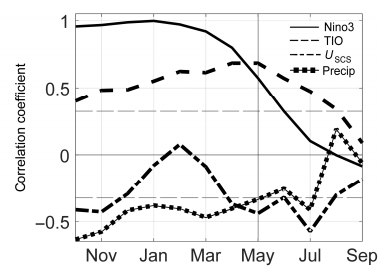
|
图 6 冬季Niño3指数与Niño3区海表温度、热带印度洋海表温度(TIO,20°S~20°N,40°E~100°E)、南海中部—南部850 hPa纬向风(USCS)及南海中部—北部降水(Precip)的相关系数的时间变化,长虚线代表 95%的置信度 Fig. 6 Evolutions of correlation coefficients between the winter Niño3 index with the Niño3 SST, the tropical Indian Ocean (TIO, 20°S−20°N, 40°E−100°E) SST, the 850-hPa zonal wind (USCS) over the central and southern part of the SCS (South China Sea), and precipitation over the central and northern part of the SCS (Precip). Long dashed lines denote the 95% confidence level |
需要强调的是,除了被El Niño激发之外,异常偏弱的东亚冬季风通过其动力作用也会有利于菲律宾海反气旋的形成(李崇银等,2005)。这暗示着东亚冬季风以及冬季风—夏季风关系并非完全是被动地接受ENSO影响。此外,青藏高原冬季积雪也会对东亚冬季风强度和南海夏季风爆发产生影响(陈乾金等,2000)。因而东亚冬、夏季风之间联系的建立,除了以ENSO为主的海洋过程之外,还可能有陆面过程的参与。
5 总结与讨论基于ERA-interim大气再分析资料、CMAP降水资料和ERSST.v4海温资料,本文采用相关和回归分析研究了东亚冬季风和南海夏季风爆发的关系,并探讨了ENSO在此关系中的作用。结果表明,弱东亚冬季风之后的南海地区5月往往出现异常反气旋、异常东风、偏少的降水,这些对应着季风爆发偏晚;而强东亚冬季风之后的南海地区5月往往出现异常气旋、异常西风、偏多的降水,这些对应着季风爆发偏早。但是上述关系在统计上并不十分显著。进一步将东亚冬季风分为与ENSO有关和无关的部分后,对于与ENSO有关的冬季风,上述结论的显著性明显提高;但对于与ENSO无关的冬季风,其与后期5月的南海大气环流、降水、季风爆发等就没有显著联系。因此,东亚冬季风—南海夏季风爆发的关系主要是由与ENSO有关的东亚冬季风异常引起的。
与ENSO有关的东亚冬季风异常则是通过菲律宾海上空的异常反气旋或气旋和南海海域的异常纬向风来影响季风的爆发。由于局地海气相互作用正反馈和印度洋电容器效应,菲律宾海异常反气旋或气旋能够从冬季维持到晚春甚至夏季,从而建立起东亚冬季风强弱和南海夏季风爆发早晚之间的联系。以伴随El Niño的弱东亚冬季风之后夏季风爆发偏晚的情形为例,一方面,El Niño事件激发出菲律宾异常反气旋使同期冬季风偏弱;另一方面,又导致热带印度洋增暖。由于局地海气相互作用正反馈和印度洋电容器效应,菲律宾异常反气旋可以维持到晚春,使得副热带高压偏强、占据南海,异常反气旋及南侧的异常东风不利于南海夏季风的爆发(图 7)。
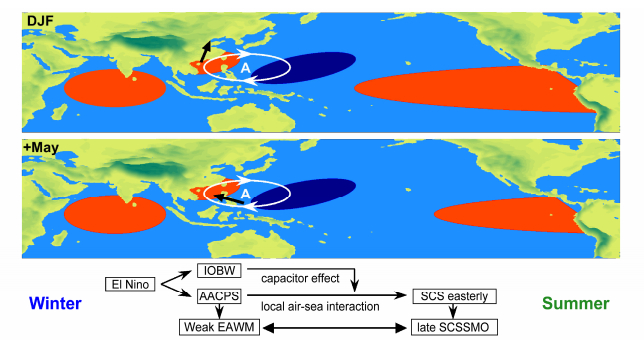
|
图 7 伴随El Niño的弱东亚冬季风之后南海夏季风爆发偏晚的机制示意图 Fig. 7 Schematic representation of the link between weak EAWM associated with El Niño and the late SCSSMO |
需要说明的是,本文讨论的是年际尺度的关联,但东亚冬季风强度、ENSO—东亚冬季风关系(Wang et al., 2008;Wang and He, 2012;Yun et al., 2014)和南海夏季风爆发、ENSO—夏季风爆发关系(Kajikawa et al., 2012;Kajikawa and Wang, 2012;Xiang and Wang, 2013;丁硕毅等,2016)均存在年代际变化。那么,东亚冬季风—南海夏季风爆发关系是否也存在年代际变化?PDO、AMO等对此是否存在调制作用?这些都需要做进一步研究。其次,本文只是分析了东亚冬季风强度和南海夏季风爆发的关系,而冬季风异常除了强弱变化外,还有路径的变化(陈文等,2013)。最后,本文采用的Niño3指数主要用于描述传统型的ENSO,未涉及中太平洋型的ENSO,而已有研究指出两类ENSO对南海夏季风爆发有不同影响(丁硕毅等,2016)。这些问题都值得今后深入研究。
致谢: 在挑选东亚冬季风指数时得到南京大学于威的帮助,写作过程中曾和中国科学院大气物理研究所季风系统研究中心的徐霈强和丁硕毅进行过有益的讨论,在此一并表示感谢!| [] | Chan J C L, Li C Y. 2004. The East Asia winter monsoon[M]//Chang C P. East Asian Monsoon. Singapore:World Scientific Publishing Co. Pet. Ltd., 54-106, doi: 10.1142/9789812701411_0002. |
| [] | Chang C P, Wang Z, Hendon H. 2006. The Asian winter monsoon[M]//Wang Bin. The Asian Monsoon. Berlin Heidelberg:Springer, 89-127, doi: 10.1007/3-540-37722-0_3. |
| [] | 陈隽, 金祖辉. 2001. 影响南海夏季风爆发因子的诊断研究[J]. 气候与环境研究, 6: 19–32. Chen Jun, Jin Zuhui. 2001. Diagnosis of factors of influence on onset over the South China Sea summer monsoon[J]. Climatic and Environmental Research (in Chinese), 6: 19–32. DOI:10.3969/j.issn.1006-9585.2001.01.003 |
| [] | 陈隽, 孙淑清. 1999. 东亚冬季风异常与全球大气环流变化Ⅰ.强弱冬季风影响的对比研究[J]. 大气科学, 23: 101–110. Chen Jun, Sun Shuqing. 1999. Eastern Asian winter monsoon anomaly and variation of global circulation Part Ⅰ:A comparison study on strong and weak winter monsoon[J]. Chinese Journal of Atmospheric Sciences (in Chinese), 23: 101–110. DOI:10.3878/j.issn.1006-9895.1999.01.12 |
| [] | Chen L, Wu R. 2000. The role of the Asian/Australian monsoons and the Southern/Northern oscillation in the ENSO cycle[J]. Theor. Appl. Climatol., 65: 37–47. DOI:10.1007/s007040050003 |
| [] | 陈隆勋, 朱乾根, 罗会邦, 等. 1991. 东亚季风[M]. 北京: 气象出版社: 362. Chen Longxun, Zhu Qiangen, Luo Huibang, et al. 1991. East Asian Monsoon (in Chinese)[M]. Beijing: China Meteorological Press: 362. |
| [] | Chen L X, Dong M, Shao Y N. 1992. The characteristics of interannual variations on the East Asian monsoon[J]. J. Meteor. Soc. Japan, 70: 397–421. DOI:10.2151/jmsj1965.70.1B_397 |
| [] | 陈乾金, 高波, 张强. 2000. 青藏高原冬季雪盖异常与冬夏季风变异及其相互联系的物理诊断研究[J]. 大气科学, 24: 477–492. Chen Qianjin, Gao Bo, Zhang Qiang. 2000. Studies on relation of snow cover over the Tibetan Plateau in winter to the winter-summer monsoon change[J]. Chinese Journal of Atmospheric Sciences (in Chinese), 24: 477–492. DOI:10.3878/j.issn.1006-9895.2000.04.05 |
| [] | 陈文. 2002. El Niño和La Niña事件对东亚冬、夏季风循环的影响[J]. 大气科学, 26: 595–610. Chen Wen. 2002. Impacts of El Niño and La Niña on the cycle of the East Asian winter and summer monsoon[J]. Chinese Journal of Atmospheric Sciences (in Chinese), 26: 595–610. DOI:10.3878/j.issn.1006-9895.2002.05.02 |
| [] | Chen W, Feng J, Wu R G. 2013. Roles of ENSO and PDO in the link of the East Asian winter monsoon to the following summer monsoon[J]. J. Climate, 26: 622–635. DOI:10.1175/JCLI-D-12-00021.1 |
| [] | Chen W, Graf H F, Huang Ronghui. 2000. The interannual variability of East Asian winter monsoon and its relation to the summer monsoon[J]. Advances in Atmospheric Sciences, 17: 48–60. DOI:10.1007/s00376-000-0042-5 |
| [] | 陈文, 顾雷, 魏科, 等. 2008. 东亚季风系统的动力过程和准定常行星波活动的研究进展[J]. 大气科学, 32: 950–966. Chen Wen, Gu Lei, Wei Ke, et al. 2008. Studies of the dynamic processes of East Asian monsoon system and the quasi-stationary planetary wave activities[J]. Chinese Journal of Atmospheric Sciences (in Chinese), 32: 950–966. DOI:10.3878/j.issn.1006-9895.2008.04.20 |
| [] | 陈文, 魏科, 王林, 等. 2013. 东亚冬季风气候变异和机理以及平流层过程的影响[J]. 大气科学, 37: 425–438. Chen Wen, Wei Ke, Wang Lin, et al. 2013. Climate variability and mechanisms of the East Asian winter monsoon and the impact from the stratosphere[J]. Chinese Journal of Atmospheric Sciences (in Chinese), 37: 425–438. DOI:10.3878/j.issn.1006-9895.2012.12309 |
| [] | Chen Z S, Wen Z P, Wu R G, et al. 2016. Relative importance of tropical SST anomalies in maintaining the western North Pacific anomalous anticyclone during El Niño to La Niña transition years[J]. Climate Dyn., 46: 1027–1041. DOI:10.1007/s00382-015-2630-1 |
| [] | Chen Z, Wu R G, Chen W. 2014. Distinguishing interannual variations of the northern and southern modes of the East Asian winter monsoon[J]. J. Climate, 27: 835–851. DOI:10.1175/JCLI-D-13-00314.1 |
| [] | Dee D P, Uppala S M, Simmons A J, et al. 2011. The ERA-Interim reanalysis:Configuration and performance of the data assimilation system[J]. Quart. J. Roy. Meteor. Soc., 137: 553–597. DOI:10.1002/qj.828 |
| [] | 丁硕毅, 温之平, 陈文. 2016. 南海夏季风爆发与热带太平洋两类海温型关系的年代际差异[J]. 大气科学, 40: 243–256. Ding Shuoyi, Wen Zhiping, Chen Wen. 2016. Interdecadal change in the relationship between the South China Sea summer monsoon onset and two types of Pacific sea surface temperature anomaly[J]. Chinese Journal of Atmospheric Sciences (in Chinese), 40: 243–256. DOI:10.3878/j.issn.1006-9895.1507.15102 |
| [] | 丁一汇. 2005. 高等天气学(2版) [M]. 北京: 气象出版社: 174-278. Ding Yihui. 2005. Advanced Synoptic Meteorology (in Chinese)(2nd ed) [M]. Beijing: China Meteorological Press: 174-278. |
| [] | Ding Y H, Liu Y J, Liang S J, et al. 2014. Interdecadal variability of the East Asian winter monsoon and its possible links to global climate change[J]. Journal of Meteorological Research, 28: 693–713. DOI:10.1007/s13351-014-4046-y |
| [] | Ding Y H, Liu Y J, Song Y F, et al. 2015. From MONEX to the global monsoon:A review of monsoon system research[J]. Advances in Atmospheric Sciences, 32: 10–31. DOI:10.1007/s00376-014-0008-7 |
| [] | Feng J, Chen W. 2014. Interference of the East Asian winter monsoon in the impact of ENSO on the East Asian summer monsoon in decaying phases[J]. Advances in Atmospheric Sciences, 31: 344–354. DOI:10.1007/s00376-013-3118-8 |
| [] | Gong D Y, Wang S W, Zhu J H. 2001. East Asian winter monsoon and Arctic oscillation[J]. Geophys. Res. Lett., 28: 2073–2076. DOI:10.1029/2000GL012311 |
| [] | 何金海, 丁一汇, 高辉, 等. 2001. 南海夏季风建立日期的确定与季风指数[M]. 北京: 气象出版社: 123. He Jinhai, Ding Yihui, Gao Hui, et al. 2001. The South China Sea Summer Monsoon Onset and Monsoon Indice(in Chinese)[M]. Beijing: China Meteorological Press: 123. |
| [] | He S P, Wang H J. 2013. Oscillating relationship between the East Asian winter monsoon and ENSO[J]. J. Climate, 26: 9819–9838. DOI:10.1175/JCLI-D-13-00174.1 |
| [] | Hu C D, Yang S, Wu Q G. 2015. An optimal index for measuring the effect of East Asian winter monsoon on China winter temperature[J]. Climate Dyn., 45: 2571–2589. DOI:10.1007/s00382-015-2493-5 |
| [] | Huang B Y, Banzon V F, Freeman E, et al. 2015. Extended reconstructed sea surface temperature version 4 (ERSST.v4). Part Ⅰ:Upgrades and intercomparisons[J]. J. Climate, 28: 911–930. DOI:10.1175/JCLI-D-14-00006.1 |
| [] | 黄菲, 李元妮. 2010. 南海夏季风爆发与西北太平洋热带气旋活动[J]. 中国海洋大学学报, 40(8): 1–10. Huang Fei, Li Yuanni. 2010. Relationship between the South China Sea summer monsoon onset and the tropical cyclone activity in the western North Pacific[J]. Periodical of Ocean University of China (in Chinese), 40(8): 1–10. DOI:10.3969/j.issn.1672-5174.2010.08.001 |
| [] | 黄荣辉, 陈文. 2002. 关于亚洲季风与ENSO循环相互作用研究最近的进展[J]. 气候与环境研究, 7: 146–159. Huang Ronghui, Chen Wen. 2002. Recent progresses in the research on the interaction between Asian monsoon and ENSO cycle[J]. Climatic and Environmental Research (in Chinese), 7: 146–159. DOI:10.3969/j.issn.1006-9585.2002.02.003 |
| [] | 黄荣辉, 陈文, 丁一汇, 等. 2003. 关于季风动力学以及季风与ENSO循环相互作用的研究[J]. 大气科学, 27: 484–502. Huang Ronghui, Chen Wen, Ding Yihui, et al. 2003. Studies on the monsoon dynamics and the interaction between monsoon and ENSO cycle[J]. Chinese Journal of Atmospheric Sciences (in Chinese), 27: 484–502. DOI:10.3878/j.issn.1006-9895.2003.04.05 |
| [] | 黄荣辉, 刘永, 皇甫静亮, 等. 2014. 20世纪90年代末东亚冬季风年代际变化特征及其内动力成因[J]. 大气科学, 38: 627–644. Huang Ronghui, Liu Yong, Huangfu Jingliang, et al. 2014. Characteristics and internal dynamical causes of the interdecadal variability of East Asian winter monsoon near the late 1990s[J]. Chinese Journal of Atmospheric Sciences (in Chinese), 38: 627–644. DOI:10.3878/j.issn.1006-9895.2013.13245 |
| [] | Kajikawa Y, Wang Bin. 2012. Interdecadal change of the South China Sea summer monsoon onset[J]. J. Climate, 25: 3207–3218. DOI:10.1175/JCLI-D-11-00207.1 |
| [] | Kajikawa Y, Yasunari T, Yoshida S, et al. 2012. Advanced Asian summer monsoon onset in recent decades[J]. Geophys. Res. Lett., 39(3): L03803. DOI:10.1029/2011GL050540 |
| [] | Kalnay E, Kanamitsu M, Kistler R, et al. 1996. The NCEP/NCAR 40-year reanalysis project[J]. Bull. Amer. Meteor. Soc., 77: 437–472. DOI:10.1175/1520-0477(1996)077<0437:TNYRP>2.0.CO;2 |
| [] | Kanamitsu M, Ebisuzaki W, Woollen J, et al. 2002. NCEP-DOE AMIP-Ⅱ Reanalysis (R-2)[J]. Bull. Amer. Meteor. Soc., 83: 1631–1643. DOI:10.1175/BAMS-83-11-1631 |
| [] | Lau K M, Yang S. 1997. Climatology and interannual variability of the Southeast Asian summer monsoon[J]. Advances in Atmospheric Sciences, 14: 141–162. DOI:10.1007/s00376-997-0016-y |
| [] | Lee J Y, Wang B, Wheeler M C, et al. 2013. Real-time multivariate indices for the boreal summer intraseasonal oscillation over the Asian summer monsoon region[J]. Climate Dyn., 40: 493–509. DOI:10.1007/s00382-012-1544-4 |
| [] | Li C Y. 1990. Interaction between anomalous winter monsoon in East Asia and El Niño events[J]. Advances in Atmospheric Sciences, 7: 36–46. DOI:10.1007/BF02919166 |
| [] | 李崇银. 2000. 气候动力学引论(2版) [M]. 北京: 气象出版社: 259-274. Li Chongyin. 2000. An Introduction to Climate Dynamics (in Chinese)(2nd ed) [M]. Beijing: China Meteorological Press: 259-274. |
| [] | 李崇银, 胡季. 1987. 东亚大气环流与埃尔尼诺相互影响的一个分析研究[J]. 大气科学, 11: 359–364. Li Chongyin, Hu Ji. 1987. A study on interaction between the East Asia atmospheric circulation and El Niño[J]. Chinese Journal of Atmospheric Sciences (in Chinese), 11: 359–364. DOI:10.3878/j.issn.1006-9895.1987.04.03 |
| [] | 李崇银, 裴顺强, 普业. 2005. 异常东亚冬季风对赤道西太平洋纬向风的动力作用[J]. 科学通报, 50: 1520–1526. Li Chongyin, Pei Shunqiang, Pu Ye. 2005. Dynamical impact of anomalous East Asian winter monsoon on zonal wind over the equatorial western Pacific[J]. Chinese Science Bulletin, 50: 1520–1526. DOI:10.3321/j.issn:0023-074X.2005.11.014 |
| [] | Li Y Q, Yang S. 2010. A dynamical index for the East Asian winter monsoon[J]. Journal of Climate, 23: 4255–4262. DOI:10.1175/2010JCLI3375.1 |
| [] | 林爱兰, 谷德军, 李春晖, 等. 2016. 赤道MJO活动对南海夏季风爆发的影响[J]. 地球物理学报, 59: 28–44. Lin Ailan, Gu Dejun, Li Chunhui, et al. 2016. Impact of equatorial MJO activity on summer monsoon onset in the South China Sea[J]. Chinese Journal of Geophysics (in Chinese), 59: 28–44. DOI:10.6038/cjg20160104 |
| [] | 刘伯奇, 何金海. 2015. 亚洲夏季风动力学研究综述[J]. 热带气象学报, 31(6): 869–880. Liu Boqi, He Jinhai. 2015. Reviews on the dynamics of Asian summer monsoon[J]. Journal of Tropical Meteorology (in Chinese), 31(6): 869–880. DOI:10.16032/j.issn.1004-4965.2015.06.015 |
| [] | Mao J Y, Wu G X. 2008. Influences of typhoon Chanchu on the 2006 South China Sea summer monsoon onset[J]. Geophys. Res. Lett., 35: L12809. DOI:10.1029/2008GL033810 |
| [] | 邵鹏程, 李栋梁. 2012. 东亚冬季风指数的分类和比较[J]. 气象科学, 32: 226–235. Shao Pengcheng, Li Dongliang. 2012. Classification and comparison of East Asian winter monsoon indices[J]. Journal of the Meteorological Sciences (in Chinese), 32: 226–235. DOI:10.3969/2012jms.0018 |
| [] | 邵勰, 黄平, 黄荣辉. 2014. 南海夏季风爆发的研究进展[J]. 地球科学进展, 29: 1126–1137. Shao Xie, Huang Ping, Huang Ronghui. 2014. A review of the South China Sea summer monsoon onset[J]. Advances in Earth Science (in Chinese), 29: 1126–1137. DOI:10.11867/j.issn.1001-8166.2014.10.1126 |
| [] | Sun B M, Sun S Q. 1994. The analysis on the features of the atmospheric circulation in preceding winters for the summer drought and flooding in the Yangtze and Huaihe River valley[J]. Advances in Atmospheric Sciences, 11: 79–90. DOI:10.1007/BF02656997 |
| [] | 孙淑清, 陈隽. 2000. 异常东亚冬季风对夏季南海地区风场及热力场的影响[J]. 气候与环境研究, 5: 400–416. Sun Shuqing, Chen Juan. 2000. The variations of wind and thermodynamics fields in the South China Sea in summer during the anomaly winter monsoon[J]. Climatic and Environmental Research (in Chinese), 5: 400–416. DOI:10.3969/j.issn.1006-9585.2000.04.007 |
| [] | 孙淑清, 孙柏民. 1995. 东亚冬季风环流异常与中国江淮流域夏季旱涝天气的关系[J]. 气象学报, 53: 440–450. Sun Shuqing, Sun Bomin. 1995. The relationship between the anomalous winter monsoon circulation over East Asia and summer drought/flooding in the Yangtze and Huaihe River valley[J]. Acta Meteorologica Sinica (in Chinese), 53: 440–450. DOI:10.11676/qxxb1995.050 |
| [] | Tao S Y, Chen L X. 1987. A review of recent research on the East Asian summer monsoon in China[M]//Chang C P, Krishnamurti T N. Monsoon Meteorology. Oxford:Oxford University Press, 60-92. |
| [] | Tong H W, Chan J C L, Zhou W. 2009. The role of MJO and mid-latitude fronts in the South China Sea summer monsoon onset[J]. Climate Dyn., 33: 827–841. DOI:10.1007/s00382-008-0490-7 |
| [] | Wang B, Li T. 2004. East Asian monsoon-ENSO interactions[M]//Chang C P. East Asian Monsoon. Singapore:World Scientific Publishing Co. Pet. Ltd., 117-212. |
| [] | Wang B, Lin H. 2002. Rainy season of the Asian-Pacific summer monsoon[J]. J. Climate, 15: 386–398. DOI:10.1175/1520-0442(2002)015<0386:RSOTAP>2.0.CO;2 |
| [] | Wang B, Wu R, Fu X. 2000. Pacific-East Asian teleconnection:How does ENSO affect East Asian climate?[J]. J. Climate, 13: 1517–1536. DOI:10.1175/1520-0442(2000)013<1517:PEATHD>2.0.CO;2 |
| [] | Wang B, Lin H, Zhang Y S, et al. 2004. Definition of South China Sea monsoon onset and commencement of the East Asia summer monsoon[J]. J. Climate, 17: 699–710. DOI:10.1175/2932.1 |
| [] | Wang B, Huang F, Wu Z W, et al. 2009. Multi-scale climate variability of the South China Sea monsoon:A review[J]. Dyn. Atmos. Oceans, 47: 15–37. DOI:10.1016/j.dynatmoce.2008.09.004 |
| [] | Wang H J, He S P. 2012. Weakening relationship between East Asian winter monsoon and ENSO after mid-1970s[J]. Chinese Science Bulletin, 57: 3535–3540. DOI:10.1007/s11434-012-5285-x |
| [] | Wang L, Chen W. 2010. How well do existing indices measure the strength of the East Asian winter monsoon?[J]. Advances in Atmospheric Sciences, 27: 855–870. DOI:10.1007/s00376-009-9094-3 |
| [] | Wang L, Chen W. 2014. An intensity index for the East Asian winter monsoon[J]. Journal of Climate, 27: 2361–2374. DOI:10.1175/JCLI-D-13-00086.1 |
| [] | Wang L, Chen W, Huang R H. 2008. Interdecadal modulation of PDO on the impact of ENSO on the East Asian winter monsoon[J]. Geophys. Res. Lett., 35: L20702. DOI:10.1029/2008GL035287 |
| [] | Wu B Y, Wang J. 2002. Winter Arctic oscillation, Siberian high and East Asian winter monsoon[J]. Geophys. Res. Lett., 29(19): 3. DOI:10.1029/2002GL015373 |
| [] | Wu M C, Chan J C L. 2005a. Observational relationships between summer and winter monsoons over East Asia. Part Ⅰ:Basic Framework[J]. International Journal of Climatology, 25: 437–451. DOI:10.1002/joc.1132 |
| [] | Wu M C, Chan J C L. 2005b. Observational relationships between summer and winter monsoons over East Asia. Part Ⅱ:Results[J]. International Journal of Climatology, 25: 453–468. DOI:10.1002/joc.1153 |
| [] | 吴尚森, 梁建茵. 2000. 华南冬季异常冷月预测概念模型Ⅱ——大气环流、极冰、积雪等物理因子特征[J]. 热带气象学报, 16: 289–296. Wu Shangsen, Liang Jianying. 2000. Schematic predictive model for extremely severe cold months in south China minter-physical factors of general circulation, polar sea ice and perpetual snow[J]. Journal of Tropical Meteorology (in Chinese), 16: 289–296. DOI:10.3969/j.issn.1004-4965.2000.04.001 |
| [] | Xiang B Q, Wang B. 2013. Mechanisms for the advanced Asian summer monsoon onset since the mid-to-late 1990s[J]. J. Climate, 26(6): 1993–2009. DOI:10.1175/JCLI-D-12-00445.1 |
| [] | 肖晓, 陈文, 范广洲, 等. 2016. 20世纪90年代末东亚冬季风年代际变化的外强迫因子分析[J]. 气候与环境研究, 21: 197–209. Xiao Xiao, Chen Wen, Fan Guangzhou, et al. 2016. Possible external forcing factors for the interdecadal change in the East Asian winter monsoon around the late 1990s[J]. Climatic and Environmental Research (in Chinese), 21: 197–209. DOI:10.3878/j.issn.1006-9585.2015.15169 |
| [] | Xie P P, Arkin P A. 1997. Global precipitation:A 17-year monthly analysis based on gauge observations, satellite estimates, and numerical model outputs[J]. Bull. Amer. Meteor. Soc., 78: 2539–2558. DOI:10.1175/1520-0477(1997)078<2539:GPAYMA>2.0.CO;2 |
| [] | Xie S P, Hu K M, Hafner J, et al. 2009. Indian Ocean capacitor effect on Indo-western Pacific climate during the summer following El Niño[J]. J. Climate, 22: 730–747. DOI:10.1175/2008JCLI2544.1 |
| [] | Xie S P, Kosaka Y, Du Y, et al. 2016. Indo-western Pacific ocean capacitor and coherent climate anomalies in post-ENSO summer:A review[J]. Advances in Atmospheric Sciences, 33: 411–432. DOI:10.1007/s00376-015-5192-6 |
| [] | 徐霈强, 冯娟, 陈文. 2016. ENSO冷暖位相影响东亚冬季风与东亚夏季风联系的非对称性[J]. 大气科学, 40: 831–840. Xu Peiqiang, Feng Juan, Chen Wen. 2016. Asymmetric role of ENSO in the link between the East Asian winter monsoon and the following summer monsoon[J]. Chinese Journal of Atmospheric Sciences (in Chinese), 40: 831–840. DOI:10.3878/j.issn.1006-9895.1509.15192 |
| [] | Xue F, Zeng Q C, Huang R H, et al. 2015. Recent advances in monsoon studies in China[J]. Advances in Atmospheric Sciences, 32: 206–229. DOI:10.1007/s00376-014-0015-8 |
| [] | Yang S, Lau K M, Kim K M. 2002. Variations of the East Asian jet stream and Asian-Pacific-American winter climate anomalies[J]. J. Climate, 15: 306–325. DOI:10.1175/1520-0442(2002)015<0306:VOTEAJ>2.0.CO;2 |
| [] | 袁媛, 李崇银. 2009. 热带印度洋海温异常不同模态对南海夏季风爆发的可能影响[J]. 大气科学, 33: 325–336. Yuan Yuan, Li Chongyin. 2009. Possible impacts of the tropical Indian Ocean SST anomaly modes on the South China Sea summer monsoon onset[J]. Chinese Journal of Atmospheric Sciences (in Chinese), 33: 325–336. DOI:10.3878/j.issn.1006-9895.2009.02.11 |
| [] | Yun K S, Seo Y W, Ha K J, et al. 2014. Interdecadal changes in the Asian winter monsoon variability and its relationship with ENSO and AO[J]. Asia-Pacific Journal of Atmospheric Sciences, 50: 531–540. DOI:10.1007/s13143-014-0042-5 |
| [] | Zhang R H, Sumi A, Kimoto M. 1996. Impact of El Niño on the East Asian monsoon:A diagnostic study of the 86/87 and 91/92 events[J]. J. Meteor. Soc. Japan, 74: 49–62. DOI:10.2151/jmsj1965.74.1_49 |
| [] | Zhang Y, Wallace J M, Battisti D S. 1997. ENSO-like interdecadal variability:1900-93[J]. J. Climate, 10: 1004–1020. DOI:10.1175/1520-0442(1997)010<1004:ELIV>2.0.CO;2 |
| [] | 赵永平, 陈永利. 2000. 南海暖池的季节和年际变化及其与南海季风爆发的关系[J]. 热带气象学报, 16: 202–211. Zhao Yongping, Chen Yongli. 2000. The seasonal and inter-annual variability of the South China Sea warm pool and its relation to the South China Sea monsoon onset[J]. Journal of Tropical Meteorology (in Chinese), 16: 202–211. DOI:10.3969/j.issn.1004-4965.2000.03.002 |
| [] | 周群, 陈文. 2014. 太阳活动11年周期对东亚冬季风与随后东亚夏季风关系的影响及其过程[J]. 气候与环境研究, 19: 486–496. Zhou Qun, Chen Wen. 2014. Impact of the 11-year solar cycle on the relationship between the East Asian winter monsoon and the following summer monsoon and the related processes[J]. Climatic and Environmental Research (in Chinese), 19: 486–496. DOI:10.3878/j.issn.1006-9585.2013.13011 |
| [] | Zhou W, Chan J C L. 2005. Intraseasonal oscillations and the South China Sea summer monsoon onset[J]. International Journal of Climatology, 25: 1585–1609. DOI:10.1002/joc.1209 |
| [] | Zhou W, Chan J C L. 2007. ENSO and the South China Sea summer monsoon onset[J]. International Journal of Climatology, 27: 157–167. DOI:10.1002/joc.1380 |
 2018, Vol. 23
2018, Vol. 23


